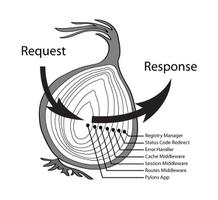在 Express.js 中使用 next() 函数
Express.js 是一个强大的工具,用于构建 Web 服务器以在后端访问 API。它有几个使其流行的优点,但它也有一些缺点,例如,需要定义不同的路由或中间件来处理来自客户端的不同传入请求。
在本文中,我们将看到如何next()在 Express.js 的中间件中使用该功能。Express.js 中有很多中间件。我们将使用中间件来定义客户端发出的特定请求的处理程序。app.use()
语法
app.use(path, (req, res, next) )
参数
path - 这是将调用中间件的路径。
callback - 这是在发生任何错误或调用下一个中间件函数时将调用的回调函数。
示例 1
创建一个名为“next.js”的文件并复制以下代码片段。创建文件后,使用命令“node next.js”运行此代码。
无next()功能
// next() 演示示例// 导入 express 模块
var express = require('express');
// 初始化 express 和端口号
var app = express();
var PORT = 3000;
// 创建中间件
app.use("/", (req, res, next) => {
console.log("Welcome to nhooo");
// 这里没有 next() 函数调用
})
// 创建另一个中间件
app.get("/", (req, res, next) => {
console.log("Get Request")
})
app.listen(PORT, function(err){
if (err) console.log(err);
console.log("Server listening on PORT", PORT);
});
如果没有该next()函数,您可以看到只调用了第一个函数,而没有调用另一个函数。
输出结果
C:\home\node>> node next.jsServer listening on PORT 3000
Welcome to nhooo
示例 2
让我们再看一个例子
// next() 演示示例// 导入 express 模块
var express = require('express');
// 初始化 express 和端口号
var app = express();
var PORT = 3000;
// 创建中间件
app.use("/", (req, res, next) => {
console.log("Welcome to nhooo");
// 在这里调用 next() 函数
next();
})
// 创建另一个中间件
app.get("/", (req, res, next) => {
console.log("Got Request")
})
app.listen(PORT, function(err){
if (err) console.log(err);
console.log("Server listening on PORT", PORT);
});
当next()函数被调用时,这两个第一功能和未来功能的调用传递的API端点。
输出结果
C:\home\node>> node next.jsServer listening on PORT 3000
Welcome to nhooo
Get Request
以上是 在 Express.js 中使用 next() 函数 的全部内容, 来源链接: utcz.com/z/361939.html






